 Nissan Versa Sedan Service ManualEngine » Engine mechanical (EM) » Cylinder block
Nissan Versa Sedan Service ManualEngine » Engine mechanical (EM) » Cylinder block
Inspection
Inspection
CRANKSHAFT END PLAY
- Measure the clearance between thrust bearings and crankshaft arm when crankshaft is moved fully forward or backward with a suitable tool (A).
- If the measured value exceeds the limit, replace thrust bearings, and measure again. If it still exceeds the limit, replace crankshaft also.
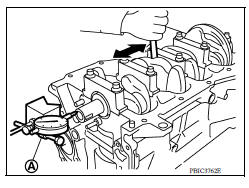
CONNECTING ROD SIDE CLEARANCE
- Measure the side clearance between connecting rod and crankshaft arm with a suitable tool (A).
- If the measured value exceeds the limit, replace connecting rod, and measure again. If it still exceeds the limit, replace crankshaft also.
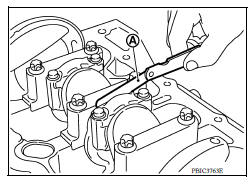
PISTON TO PISTON PIN OIL CLEARANCE
Piston Pin Hole Diameter Measure the inner diameter of piston pin hole with an suitable tool (A).
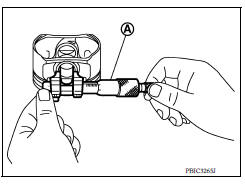
Piston Pin Outer Diameter Measure the outer diameter of piston pin with a suitable tool (A).

Piston to Piston Pin Oil Clearance (Piston to piston pin oil clearance) = (Piston pin hole diameter) - (Piston pin outer diameter)
- If oil clearance is out of the standard, replace piston and piston pin assembly.
- When replacing piston and piston pin assembly.
NOTE:
- Piston is available together with piston pin as assembly.
- Piston pin (piston pin hole) grade is provided only for the parts installed at the factory. For service parts, no grades can be selected. Only grade "0" is available.
PISTON RING SIDE CLEARANCE
- Measure the side clearance of piston ring and piston ring groove with a suitable tool (A).
- If the measured value exceeds the limit, replace piston ring, and measure again. If it still exceeds the limit, replace piston also.
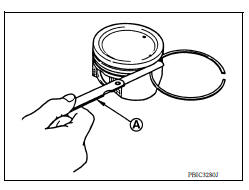
PISTON RING END GAP
- Check that cylinder bore inner diameter is within specification. Refer to "PISTON TO CYLINDER BORE CLEARANCE".
- Lubricate piston (1) and piston ring (2) with new engine oil and then insert (A) piston ring until middle of cylinder (B) with piston, and measure piston ring end gap with a feeler gauge (C).
- If the measured value exceeds the limit, replace piston ring, and measure again. If it still exceeds the limit, replace cylinder block.
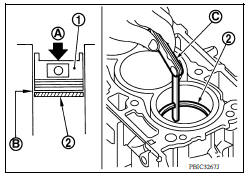
CONNECTING ROD BEND AND TORSION
- Check with a connecting rod aligner.
(A) : Bend
(B) : Torsion
(C) : Feeler gauge
- If it exceeds the limit, replace connecting rod assembly.
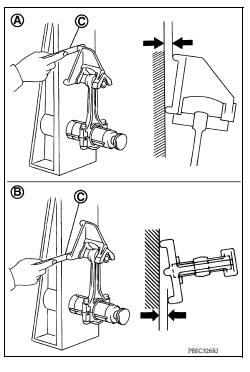
CONNECTING ROD BIG END DIAMETER
- Install connecting rod cap (1) without connecting rod bearing installed, and tightening connecting rod cap bolts to the specified torque.
(2) : Connecting rod
(A) : Example
(B) : Measuring direction of inner diameter
- Measure the inner diameter (B) of connecting rod big end with a suitable tool.
- If out of the standard, replace connecting rod assembly.
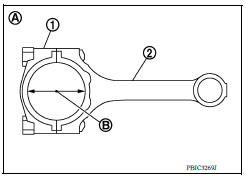
CONNECTING ROD BUSHING OIL CLEARANCE
Connecting Rod Bushing Inner Diameter Measure the inner diameter of connecting rod bushing with a suitable tool (A).
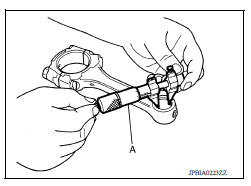
Piston Pin Outer Diameter Measure the outer diameter of piston pin with a micrometer (A).
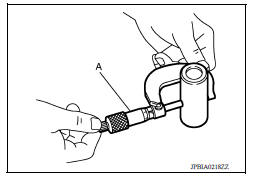
Connecting Rod Bushing Oil Clearance (Connecting rod bushing oil clearance) = (Connecting rod bushing inner diameter) - (Piston pin outer diameter)
- If the measured value is out of the standard range, replace connecting rod assembly and/or piston and piston pin assembly.
- If replacing piston and piston pin assembly.
- If replacing connecting rod assembly.
CYLINDER BLOCK TOP SURFACE DISTORTION
- Using a scraper, remove gasket on the cylinder block surface, and also remove engine oil, scale, carbon, or other contamination.
CAUTION:
Be careful not to allow gasket particles to enter engine oil or engine coolant passages.
- Measure the distortion on the cylinder block upper face at different points in six directions with a suitable tool (A) and (B).
- If it exceeds the limit, replace cylinder block.
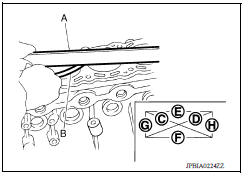
MAIN BEARING HOUSING INNER DIAMETER
- Install main bearing cap without main bearings installed, and tighten main bearing cap bolts to the specified torque.
- Measure the inner diameter of main bearing housing with a suitable tool.
- Measure the position shown [5 mm (0.20 in)] backward from main bearing housing front side in the 2 directions as shown. The smaller one is the measured value.
(1) : Cylinder block
(2) : Main bearing cap
 : Engine front
: Engine front
- If out of the standard, replace cylinder block and main bearing caps assembly.
NOTE:
Main bearing caps cannot be replaced individually, because they are machined together with cylinder block.

PISTON TO CYLINDER BORE CLEARANCE
Cylinder Bore Inner Diameter
- Using a suitable tool, measure the cylinder bore for wear, outofround and taper at six different points on each cylinder. [(A) and (B) directions at (C), (D), and (E)] [(A) is in longitudinal direction of engine]
(f) : 10 mm (0.39 in)
(g) : 60 mm (2.36 in)
(h) : 124 mm (4.88 in)
NOTE:
When determining cylinder bore grade, measure the cylinder bore (B) direction at (D) position.
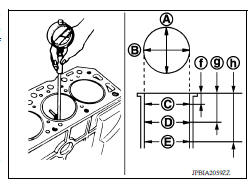
- If the measured value exceeds the limit, or if there are scratches and/or seizure on the cylinder inner wall, replace cylinder block.
NOTE:
Oversize piston is not available.
Piston Skirt Diameter Measure the outer diameter of piston skirt with a suitable tool (A).
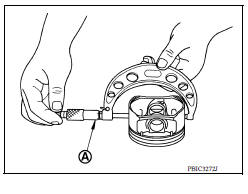
Piston to Cylinder Bore Clearance Calculate by piston skirt diameter and cylinder bore inner diameter [direction (B), position (D)].
(A) : Direction A
(C) : Position C
(E) : Position E
(f) : 10 mm (0.39 in)
(g) : 60 mm (2.36 in)
(h) : 124 mm (4.88 in)
(Clearance) = (Cylinder bore inner diameter) - (Piston skirt diameter)

- If it exceeds the limit, replace piston and piston pin assembly and/or cylinder block.
CRANKSHAFT MAIN JOURNAL DIAMETER
- Measure the outer diameter of crankshaft main journals with a suitable tool (A).
- If out of the standard, measure the main bearing oil clearance.
Then use undersize bearing.

CRANKSHAFT PIN JOURNAL DIAMETER
- Measure the outer diameter of crankshaft pin journal with a suitable tool.
- If out of the standard, measure the connecting rod bearing oil clearance.
OUTOFROUND AND TAPER OF CRANKSHAFT
-
Measure the dimensions at four different points as shown on each main journal and pin journal with a suitable tool.
-
Outofround is indicated by the difference in dimensions between (a) and (b) at (c) and (d).
-
Taper is indicated by the difference in dimension between (c) and (d) at (a) and (b).
-
If the measured value exceeds the limit, correct or replace crankshaft.
-
If corrected, measure the bearing oil clearance of the corrected main journal and/or pin journal. Then select main bearing and/or connecting rod bearing.

CRANKSHAFT RUNOUT
- Place a Vblock on a precise flat table to support the journals on both ends of the crankshaft.
- Place a suitable tool (A) straight up on the No. 3 journal.
- While rotating crankshaft, read the movement of the pointer on the suitable tool. (Total indicator reading)
- If it exceeds the limit, replace crankshaft.

CONNECTING ROD BEARING OIL CLEARANCE
Method by Calculation
- Install connecting rod bearings (2) to connecting rod (3) and connecting rod cap (1), and tighten connecting rod cap bolts to the specified torque.
(A) : Example
(B) : Inner diameter measuring direction
- Measure the inner diameter of connecting rod bearing with a suitable
tool.
(Bearing oil clearance) = (Connecting rod bearing inner diameter) - (Crankshaft pin journal diameter)

- If clearance exceeds the limit, select proper connecting rod bearing according to connecting rod big end diameter and crankshaft pin journal diameter to obtain specified bearing oil clearance.
Method of Using Plastigage
- Remove engine oil and dust on crankshaft pin and the surfaces of each bearing completely.
- Cut a plastigage slightly shorter than the bearing width, and place it in crankshaft axial direction, avoiding oil holes.
- Install connecting rod bearings to connecting rod and cap, and tighten connecting rod cap bolts to the specified torque.
CAUTION:
Do not rotate crankshaft.
- Remove connecting rod cap and bearing, and using the scale (A) on the plastigage bag, measure the plastigage width.
NOTE:
The procedure when the measured value exceeds the limit is same as that described in the "Method by Calculation".

MAIN BEARING OIL CLEARANCE
Method by Calculation
- Install main bearings (3) to cylinder block (1) and main bearing cap (2), and tighten main bearing cap bolts to the specified torque.
(A) : Example
(B) : Inner diameter measuring direction
- Measure the inner diameter (B) of main bearing (3) with a suitable
tool.
(Bearing oil clearance) = (Main bearing inner diameter) - (Crankshaft main journal diameter)
- If clearance exceeds the limit, select proper main bearing according to main bearing inner diameter and crankshaft main journal diameter to obtain specified bearing oil clearance.

Method of Using Plastigage
- Remove engine oil and dust on crankshaft main journal and the surfaces of each bearing completely.
- Cut a plastigage slightly shorter than the bearing width, and place it in crankshaft axial direction, avoiding oil holes.
- Install main bearings to cylinder block and main bearing cap, and tighten main bearing cap bolts to the specified torque.
CAUTION:
Do not rotate crankshaft.
- Remove main bearing cap and bearings, and using the scale (A) on the plastigage bag, measure the plastigage width.
NOTE:
The procedure when the measured value exceeds the limit is same as that described in the "Method by Calculation".

MAIN BEARING CRUSH HEIGHT
- When main bearing cap is removed after being tightened to the specified torque with main bearings (1) installed, the tip end of bearing must protrude (B).
(A) : Example
Standard : There must be crush height.
- If the standard is not met, replace main bearings.

CONNECTING ROD BEARING CRUSH HEIGHT
- When connecting rod cap is removed after being tightened to the specified torque with connecting rod bearings (1) installed, the tip end of bearing must protrude (B).
(A) : Example
Standard : There must be crush height.
- If the standard is not met, replace connecting rod bearings.
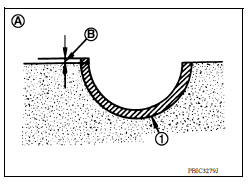
MAIN BEARING CAP BOLT OUTER DIAMETER
- Measure the outer diameters (d1) and (d2) at two positions as shown.
(A) : (d1) measuring position
(B) : (d2) measuring position
- If reduction appears in places other than (B) range, regard it as (d2).
Limit [(d1) - (d2)]: 0.2 mm (0.0078 in)
- If it exceeds the limit (a large difference in dimensions), replace main bearing cap bolt with a new one.

CONNECTING ROD CAP BOLT OUTER DIAMETER
- Measure the outer diameter (d) at position as shown.
- If reduction appears in a position other than (d), regard it
Limit: 7.75 mm (0.3051 in)
- When (d) is less than the limit (when it becomes thinner), replace connecting rod cap bolt with a new one.
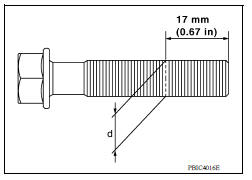
FLYWHEEL DEFLECTION (M/T models)
- Measure the deflection of flywheel contact surface to torque with a suitable tool (A).
- Measure the deflection at 210 mm (8.27 in) diameter.
Limit : 0.45 mm (0.0177 in) or less.
- If measured value is out of the standard, replace flywheel.
- If a trace of burn or discoloration is found on the surface, clean it with sandpaper.
CAUTION:
When measuring, keep magnetic fields (such as dial indicator stand) away from signal plate of the rear end of crankshaft.

